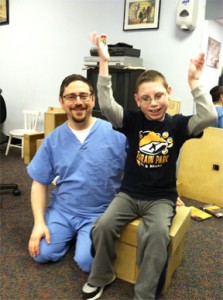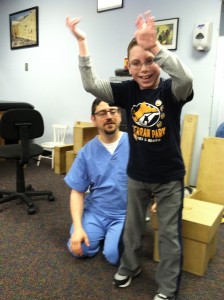 1- Every child is evaluated using the CME Evaluation which has 41 individual subtests that assess the child’s head control, trunk control, protective extension in their arms, weight bearing on their legs, and ability to come to stand and take steps. This evaluation focuses on the child’s ability to automatically come up against gravity and move while upright against gravity with as much independence as possible.
1- Every child is evaluated using the CME Evaluation which has 41 individual subtests that assess the child’s head control, trunk control, protective extension in their arms, weight bearing on their legs, and ability to come to stand and take steps. This evaluation focuses on the child’s ability to automatically come up against gravity and move while upright against gravity with as much independence as possible.
2- For younger children analyzing the score will help determine if and identify where there are delays in the child’s gross motor development and ability. This information will be used as a guide to identify and treat these specific deficits. This information, together with the medical information and parent goals provided in the questionnaire will help the therapist create appropriate and measurable goals that will be used to determine the effectiveness of the therapy. Also, the family is able to witness firsthand the strengths and limitations of the therapy offered determining that the therapy is appropriate for their child and only upon the parent’s consent is this therapy initiated.
3- In collaboration with the family a frequency and duration of therapy is determined. Current literature in physical therapy and developmental medicine lacks definitive data on prescribing a specific frequency or duration of PT. Therefore, a collaborative approach with the parents, family doctors and therapist is used to make this decision incorporating many factors including, finances, availability of child and therapist as well as proximity to the therapy center. The child can be seen for weekly or intensive therapy or in combination of both approaches. Each method can also be tried at different times for each individual child to help determine which dose of therapy is more beneficial to that child.
Weekly Therapy: A child can be seen 1-3 times per week for 30 – 45 minutes at a time on a weekly basis. This is usually implemented for children who live near the center and want ongoing care. Because no therapy is the panacea or cure-all, all other therapies should continue with the child. We gladly coordinate care with other therapists many of whom use various other techniques and nearly all the children we currently treat in fact do so. Parents are always present and welcome in therapy and their involvement is essential in administering and monitoring care and intervention, particularly as it relates to discipline and motivation. A home program respectful of the parent’s ability and time to invest is taught and implemented in a quilt free manner. The therapist is an expert in therapy while the parent is an expert in their child.
Intensive Therapy: A child can be seen 1-2 times per day for 45 minutes each session for 1-4 weeks at a time to maximize the therapeutic input at a given time. The child is then not seen again for about 2-4 months so a home program is taught to the parent, caregiver or other therapists involved with the child on a regular basis. This is most effective for children who live far from the center. This frequency also requires more carry over at home by family or therapists who work with the child on a regular basis. According to current literature this type of intervention seems to show better results than seeing a child 1-2 x per week.
4- After about6-8 weeks of therapy, the child is reassessed to determine if there is progress made toward meeting the original goals. If no progress is made or if the parent at any time feels that the progress (return) is not commensurate with the cost (time, money, effort of the parent or child) therapy is discontinued and recommendations are made to other avenues of treatment. Parent input in to the decision to continue or discontinue therapy is vital and the parent(s) is/are present and involved with all therapy sessions.
5- While we have been successful in helping many children obtain free walking without assistive devices, such an amazing and hoped for outcome is not possible in all cases and in all situations. However, that should not interfere with giving maximal effort as free walking is not the only measure of success in therapy. Any progress made toward the child’s independence against gravity will only help the child function to their maximum ability. The path to success is long and hard and most children will succeed to the maximum that they are able. Many children treated here are seen for a long period of time and the decision to continue or discontinue therapy is made in collaboration between the family and the therapist constantly assessing realistic goals and progress the child is making while evaluating the cost benefit ratio outlined above. Also, as a child gets older, other factors in the child’s and family’s life take priority or cause a shift in priorities necessitating a decrease or a discontinuation of therapy in our center. This may lead to recommendations to other avenues of intervention needed such as other therapies and / or community centered programs including dance, rock climbing or martial arts. All of these factors go into deciding  when the child should be discharged from therapy and we are happy to assist the parents with making these vital and difficult decisions as the need arises.
when the child should be discharged from therapy and we are happy to assist the parents with making these vital and difficult decisions as the need arises.
Please feel free to talk with us about any concerns you may have.


